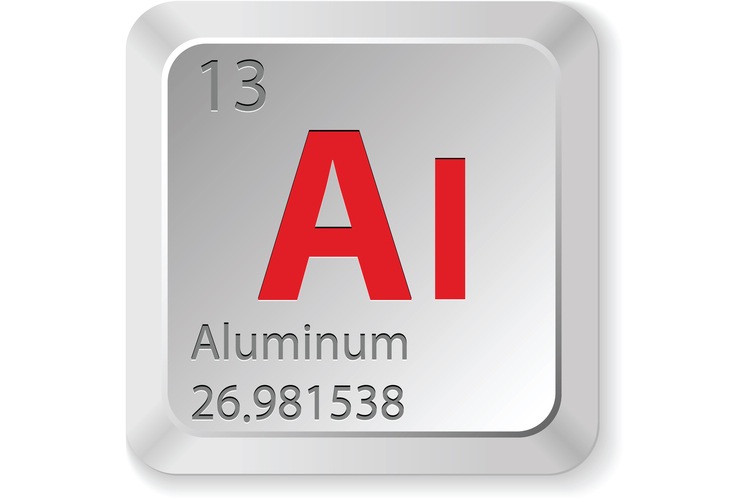Facts About Aluminum

Aluminum: It's not just found in the refrigerator wrapped around week-old leftovers. This element is the second-most abundant metallic element in Earth's crust after silicon. It's used in soda cans and other packaging, in aircraft and automobiles, and even in that snazzy iPhone 6.
Aluminum's sheer bulk — some 8 percent of the Earth's crust by weight, according to the University of Wisconsin — makes it easy to take this metal for granted. But aluminum is lightweight (a third the weight of steel or copper, according to the U.S. Geological Survey) and easy to mold, fold and recycle. It resists corrosion and stands up to repeated use.
The funny thing about aluminum is that it shouldn't be so useful at all. The metal actually oxidizes, or loses electrons, easily, the same type of reaction that causes iron to rust. However, unlike flakey iron oxide, the product of this reaction, aluminum oxide, sticks to the original metal, shielding it from further decay, according to the University of Wisconsin.
Just the Facts
- Atomic Number (number of protons in the nucleus): 13
- Atomic Symbol (on the Periodic Table of Elements): Al
- Atomic Weight (average mass of the atom): 26.9815386
- Density: 2.70 grams per cubic centimeter
- Phase at Room Temperature: Solid
- Melting Point: 1,220.58 degrees Fahrenheit (660.32 degrees Celsius)
- Boiling Point: 4,566 degrees F (2,519 degrees C)
- Number of isotopes (atoms of the same element with a different number of neutrons): 22, one stable
- Most common isotopes: Al-27 (stable) and Al-26 (radioactive; half-life 730,000 years)
Miracle metal
Aluminum forms in stars in a fusion reaction in which magnesium picks up an extra proton, according to Chemicool, a chemistry website created by David D. Hsu of the Massachusetts Institute of Technology. It isn't found in pure form in nature, however; in the Earth's crust, aluminum occurs most frequently as a compound called alum (potassium aluminum sulfate).
Danish chemist Hans Christian Oersted first managed to extract aluminum from alum in 1825, according to the Thomas Jefferson National Accelerator Facility. Later scientists refined the process for wresting aluminum for alum, but were unable to bring the price down to practical levels. For decades, aluminum was more highly prized than gold: Napoleon III, the first president of the French Second Republic beginning in 1848, proudly served his most honored guests using aluminum plates and cutlery, because it was such a rare metal, according to The Aluminum Association. Napoleon III also reportedly had an aluminum rattle made for his son, according to a 1911 article in Good Housekeeping Magazine.
Finally, in 1886, a French engineer named Paul Heroult and an Oberlin chemistry graduate named Charles Hall independently invented a process in which aluminum oxide is melted in cryolite (sodium aluminum fluoride) and subjected to an electric current, according to the American Chemical Society. The Hall-Heroult process is still used to produce aluminum today, along with the Bayer process, which extracts aluminum from bauxite ore, according to the ACS.
Aluminum's only stable form is Al-27, and most isotopes have half-lives of mere milliseconds, meaning they are gone in less than a blink of an eye. But Al-26, aluminum's longest-lasting radioactive isotope, has a half-life of about 730,000 years. This isotope is found in star-forming regions in the galaxy, according to a January 2006 study in the journal Nature. In that study, NASA researchers used detectable bursts of Al-26 to pinpoint supernovas, or star explosions. Using these Al-26 fingerprints, the scientists estimated that a supernova occurs every 50 years, on average, in the Milky Way galaxy, and that every year, seven new stars are born.
Get the world’s most fascinating discoveries delivered straight to your inbox.
Who knew?
- Aluminum is plentiful: In 2012, according to the U.S. Environmental Protection Agency (EPA), 1.9 million tons of aluminum were produced for containers and packaging alone. Another 1.7 million tons went toward appliances, vehicle parts and other durable goods.
- A single Boeing-747 contains 147,000 pounds (more than 66,000 kilograms) of aluminum, according to Chemicool.
- Don't try this at home (unless you have a fume hood). Aluminum powder plus iodine plus a few drops of water create quite a display: Clouds of toxic purple iodine vapor and then sudden flame. The reaction is a demonstration of how reactive aluminum can really be.
- Recycle! Recycling aluminum takes only 5 percent of the energy needed to extract new aluminum from ore, according to the EPA. As of 2012, about 55 percent of aluminum drink cans made it into the recycling bin.
- The top of the Washington Monument is capped with an 8.9-inch (22.6 centimeters) aluminum pyramid. The aluminum cap initially served as the apex of the monument's lightning rod, though it had to be augmented with copper rods when it became clear that the cap alone could not prevent damage, according to a 1995 article in the Journal of the Minerals, Metals and Materials Society.
- That can of Coke may not have been off the shelf for long. According to the Aluminum Association, an aluminum can takes as little as 60 days to return as a new can after recycling.
- Trippy: About 75 percent of all aluminum ever made is still in use, thanks to recycling, according to the Aluminum Association.
Current research
Perhaps aluminum's most famous appearance on the recent research scene was in 2011, when it played a role in the Nobel Prize in Chemistry. The winner of the prize, materials scientist Dan Shechtman of the Technion-Israel Institute of Technology, discovered quasicrystals, molecular structures of non-repeating patterns. The material in which Shechtman discovered these quasicrystals was a mixture of manganese and aluminum.
There are hundreds of aluminum alloys, or mixes with other metals, on the market, according to Yuntian Zhu, a professor of materials and engineering science at North Carolina State University. Aluminum alone is light but weak, so other metals are added to give it more muscle.
Zhu and his colleagues took this concept to an extreme, creating aluminum as strong as steel, they reported in a paper published in the journal Nature Communications in 2010. By subjecting aluminum mixed with a little magnesium and zinc to extreme pressure, the researchers found that they could mash the grains of aluminum down to nano-size. These smaller grains allow the alloy to move, so that it doesn't become brittle and snap like ceramic under pressure. But the movement is grudging enough that the material remains very strong.
"The nanostructure makes it very hard for dislocation to move, but at the same time, when you apply a force that is high enough, it will allow it to move," Zhu told Live Science.
Currently, the researchers can only make small amounts of this super-strength aluminum alloy at a time, meaning commercial applications aren't yet possible.
Meanwhile, in Oregon, researchers are using cutting-edge technology to study aqueous aluminum, or aluminum compounds formed in water, particularly aluminum oxides. Aluminum oxides are compounds that include both aluminum and oxygen.
"Aluminum oxide, especially in film form, is used in a lot of different industries," said Douglas Keszler, the director of the Center for Sustainable Materials Chemistry at Oregon State University. These films make good scratch-resistant, corrosion-resistant barriers; aluminum oxides are also used in water treatment to precipitate out tiny particles, Keszler told Live Science.
Keszler and his team are working to analyze the ink-like solutions that can be heated and dried into aluminum oxide films.
"We don't have the chemical techniques that allow us simultaneously, with such solutions, to identify both the composition and the structure, the molecular structure of what is in the solution," Keszler said. "So what we've done is take some brand-new laser techniques and combine that with high-power computations to be able to simultaneously deduce the composition and the structure."
Once they understand the solutions, Keszler said, the researchers can better control the process of producing the films — and learn to make them in energy-efficient ways. Right now, the team is most excited about using the films for electron tunneling. By sandwiching a very pure aluminum oxide film between two electrodes, Keszler said, the scientists are very close to getting electrons to jump from one electrode to the other without ever interacting with the film: "Essentially, instantaneous transfer from one electrode to the other," Keszler said.
This electron-tunneling device could be used as a cheap and simple switch, Keszler said.
Additional resources
- Here's an inside look at why aluminum costs perhaps more than it should — an investigative report by the New York Times on the inflated price of aluminum.
- Look under the hood of an iPhone and find out what chemical elements, such as aluminum, make the smartphone tick in this video produced by the American Chemical Society.
- This Discovery channel video gives a visual look at how aluminum cans are recycled.
- Did you know that sci-fi writer Jules Verne wrote about an aluminum space rocket in his novel "Journey to the Moon" — Find out more historical facts about aluminum at the Aluminum Association website.
Follow Live Science @livescience, Facebook & Google+.

Stephanie Pappas is a contributing writer for Live Science, covering topics ranging from geoscience to archaeology to the human brain and behavior. She was previously a senior writer for Live Science but is now a freelancer based in Denver, Colorado, and regularly contributes to Scientific American and The Monitor, the monthly magazine of the American Psychological Association. Stephanie received a bachelor's degree in psychology from the University of South Carolina and a graduate certificate in science communication from the University of California, Santa Cruz.


